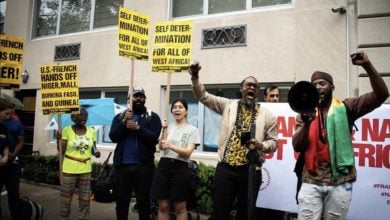Michael Prysner is an Iraq war veteran and co-founder of March Forward! He is one of several veterans with the Our Lives Our Rights campaign deploying to Fort Lewis to organize soldiers against their upcoming deployment to Afghanistan.
“We will train the Afghan forces. And then, our troops will come home.”
This was the fundamental assertion of President Obama’s major Afghanistan speech in December 2009 at West Point. I remember watching the address with Iraq and Afghanistan war veterans, and with military family members who had sons and daughters overseas facing deployment or battling the effects of war.
The president had a hard sell. It was nearly a decade into an unpopular war—with no clearly defined purpose, atrocities against civilians and popular resistance growing among the Afghan people. Budget cuts from the banks’ crisis were making war funds ever more unavailable to people’s needs. The reactions in that room when President Obama told those families their loved ones would go to Afghanistan for at least the next two years showed how deeply the desire for the war to end is felt—the choking back of tears; mothers burying their faces; families clinging together as if to brace themselves against a tidal wave.
But some clung to a little piece of hope; two years was a long time—but the end was in sight. Service members and their families were given the assurance that if they just pushed through a couple more years, the past decade of constant deployments would be over and their lives could be normal.
A lost war, a pointless mission
The war against the Afghan people—who never had anything to do with the 9/11 attacks—should never have started to begin with. Like in Iraq, the politicians saw Afghanistan as a new base of geostrategic and economic interests. But their arrogant expectation that the region could be easily dominated turned out to be a fantasy.
Recent developments have exposed the pillars of the U.S. strategy for “victory” in Afghanistan to be complete failures.
Total withdrawal of U.S. military forces from Afghanistan was never really on the table. This lie was exposed when President Obama confused many of the military families who accepted his 2014 withdrawal date by introducing and signing an agreement that secured U.S. troops on the ground until 2024.
But the strategy of the Obama administration was, as they said, to vastly reduce the number of U.S. troops in the country (to stay in fortified U.S. bases while Afghan counterparts took over security in villages and the countryside.) This would be done, as President Obama outlined in his December 2009 speech, by tripling the size of the U.S. occupation to decisively beat back the resistance movement and lure them the Taliban into a peace deal, while simultaneously training Afghan army and police forces to take the place of U.S. troops on the front lines.
Today, that strategy has completely gone up in smoke.
Not only have the U.S./NATO occupation forces failed to adequately train Afghan forces to replace them—those Afghan forces are now the number one killer of U.S./NATO soldiers. Even the highest-ranking generals in the most fortified bunkers in the most secure bases must always wear armor and keep a loaded weapon—not exactly the kind of partnership the generals had in mind.
The “insider killings” expose the hopelessness of convincing the Afghan population to pledge allegiance to the invader. And the generals have no idea what to do about it. So what they do, as Lt. Col. Daniel Davis exposed in his official assessment of the war, is simply lie about the progress and ability of the Afghan forces. The Afghan people, like all people, do not want to live under foreign occupation.
Obama’s “troop surge,” which began in 2009, was supposed to be “the beginning of the end” of the war. By the end of the offensive, the resistance forces were expected to be battered and weary, and eager to accept a peace agreement with the U.S./NATO occupation. This past September, that offensive ended.
The result of the troop surge is encompassed in the Sept. 14 attack on Camp Bastion, one of Afghanistan’s biggest and most fortified bases, home to Britain’s Prince Harry himself. Resistance fighters launched an offensive that breached the walls of the base—the complexity of which cannot be overstated. Fighters ran around freely inside the base for over four and a half hours, killing Marines and destroying multimillion-dollar Harrier jets, refueling stations and more. Spectacular attacks like this are carried out with relative ease by resistance forces anywhere in the country they choose. Resistance forces control most of the country. The momentum of the armed insurgency only picked up steam through the surge, and is far stronger today than ever before.
And now, as The New York Times reported on Oct. 2, U.S. officials have abandoned all hope of a peace agreement with the Taliban—their only chance at a “victory.”
Paving the retreat with bodies and limbs
The politicians and generals now know (and admit behind closed doors) that the war is a lost cause, with no hope of achieving their military objectives. If a military retreat is inevitable, why are they not doing it now? Why are soldiers and Marines still being sent to lose legs on patrols in mine-infested fields that have no strategic importance?
Instead of withdrawing immediately, which the vast majority of people in the United States and Afghanistan favor, the political and military establishment prefer a slow, dragged-out withdrawal—a “slow-motion retreat” —just to hide the reality that they have lost the war. None of them want to deal with the embarrassment.
By their calculations, they can manage this level of U.S. and civilian casualties. By their logic, a monthly toll of 40 or 50 dead U.S. troops and a couple of scandals over “collateral damage” can continue without much domestic backlash. So they sit back, assure the media that all is well, and continue sending wave after wave of young service members on pointless, bloody missions while their careers are protected.
In this multi-year “withdrawal,” countless more U.S. soldiers and innocent Afghans will die or suffer life-changing wounds for nothing.
The patrols through Afghanistan’s farmland, countryside and villages—taking lives and limbs every day—have no purpose other than to cover up the defeat the U.S. military has been dealt so privileged politicians can save face.
Fighting back from within the war machine
This strategy of paving the deliberately slow U.S. exit with the blood of U.S. troops and Afghans is only being maintained because it is deemed manageable on the domestic front.
While the Pentagon’s failure is exposed, a movement that fights against the war has the potential to turn the tide.
The U.S. war machine’s defeat in Afghanistan can be one that ends with a years-long trail of bodies, or it can be the crisis that is seized upon by the people that forces the war to end immediately.
That’s why I, along with other veterans of the so-called “War on Terror”, am deploying to Fort Lewis to talk to soldiers scheduled to deploy to Afghanistan about their right to resist. Service members, organizing together against the callous orders of the generals and politicians, can end the war themselves. Click here to learn more about this bold action.





